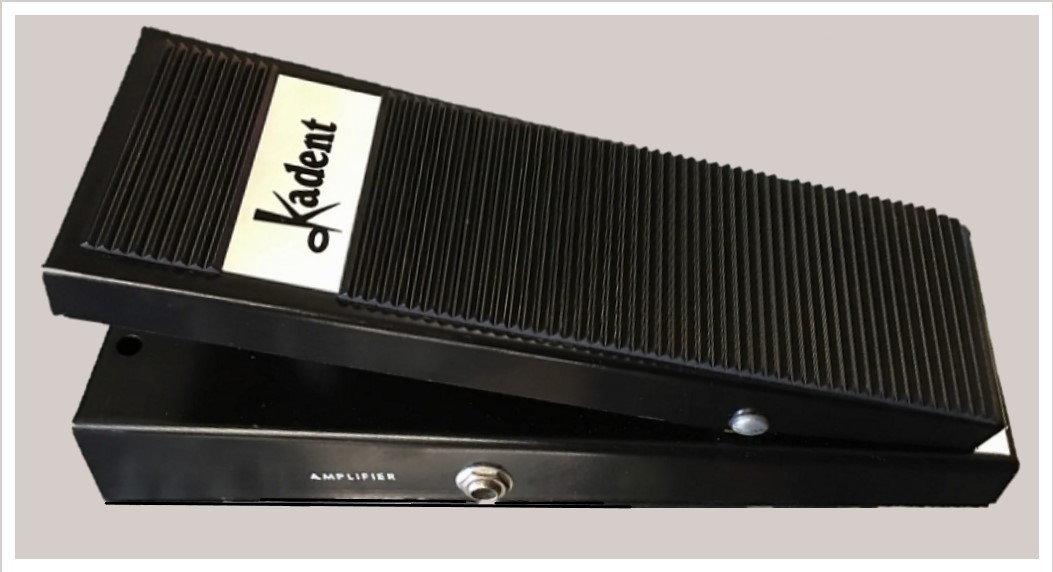The Kadent Wah/Swell Pedal
Last updated 02/18/23
By Paul Marossy
This is another obscure wah pedal that I stumbled upon while on ebay.
I just had to get my hands on this interesting relic of the past so I could study that linkage system, analyze the very
different inductor, generate a schematic and a factory PCB layout. This is another case where I could find very little info about this unit,
especially on the straight wah version (they also had a fuzz wah). The one schematic I did find (the Guild FW-3) is not correct with respect to the wah section, so
in my typical fashion I had to fill this void on the internet.I had no idea how convoluted the story of this wah pedal was going to be.
These were made sometime between 1967 and the early 1970s. At first I thought that maybe it was
made by Shin Ei, but after doing a little research it became apparent that it wasn't made by Shin Ei. It certainly does appear like there is an
association with the Shin Ei design, but when you compare circuit boards it becomes immediately apparent that the two are completely different animals. The
Shin Ei utilizes NPN transistors and the Kadent uses PNP transistors. I can't think of any other wah only circuit that uses PNP transistors.
The Shin Ei circuit uses a 750mH small transformer for the inductor and the Kadent circuit uses a 430mH inductor which looks like a big axial
capacitor. These are in fact filter chokes being pressed into service as an inductor. One can see how the external similarities might lead
people to mistakenly believe that these Kadent wah pedals were made by Shin Ei. When you take a closer look at the enclosures, while they look very
similar, one is not just a carbon copy of the other. The treadles are not the same, nor are the bottom plates. The bottom half of the enclosure is nearly
indentical to the Shin Ei, but on the bottom plate there is no battery door and there are only four screws instead of six. Another place where it becomes very apparent that this is not
the case is where the pot/treadle linkage is concerned - the Kadent uses a very simple and unique linkage system, and not the rack and pinion gear
system that we are accustomed to seeing on most wah pedals, including the Shin Ei. It really is pretty clever.
It appears that the actual manufacturer of this wah pedal was Applied Audio. There are at least seven other brands with Applied Audio circuit boards which appear in the
following wah pedals and/or wah-fuzz pedals that look exactly the same but with different name plates: Atlantic, Banshee, Crown, Guild Stinger, Jax USA, Magnum and V-Jay. I am not sure of which one was first on
the market or when. I guess we will never know if Shin Ei actually copied this design or if it was the other way around, I have no way to verify that. To add to the
confusion, there IS a JAX wah pedal that definitely was made by Shin Ei and uses a Shin-Ei enclosure. It seems that there was a frenzy of copycats when the first Vox wah
was released. Applied Audio was a business owned by Jack Gentul and was based in Manville, NJ. The business was in operation for a few years before he decided to close
the doors and go into real estate instead. To learn more about Jack and Applied Audio,
CLICK HERE. There is a short section about
Applied Audio towards the bottom but more interesting was his Hilgen amplifier designs!
I am impressed by the build quality of this obscure relic of the past. They actually seem to be pretty well made, and more surprising is how great it sounds! It has a very wide sweep reminiscent of the
Colorsound wah pedal. It also doubles as a volume swell pedal. The one weak link is that "bypass" switch. It can be noisy upon switching, which gets amplified by
your amp, but it may just be that it needs a good cleaning. That is a minor issue that can be fixed.
Below are some details of the Kadent wah pedal.
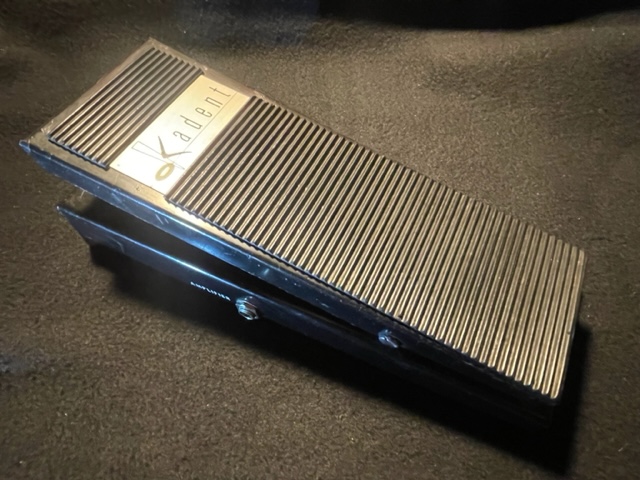 |
I like the look of it. Simple and very sturdy. Kind of looks like something you could have bought at Sears back in the day. |
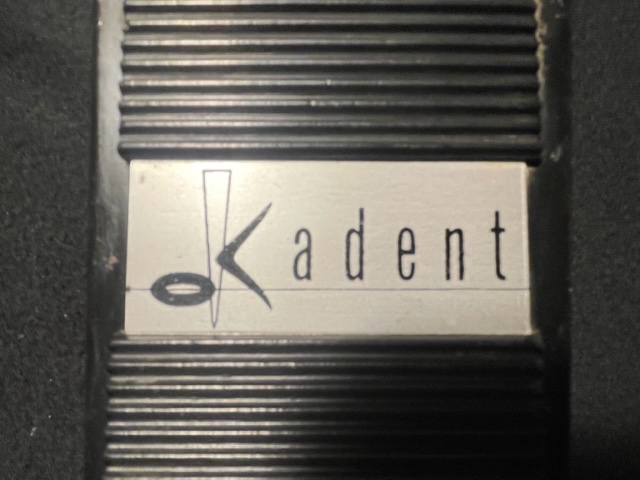 |
Here is the nameplate on the treadle. There are at least two versions of the logo. The style definitely looks like the latter part of the sixties. |
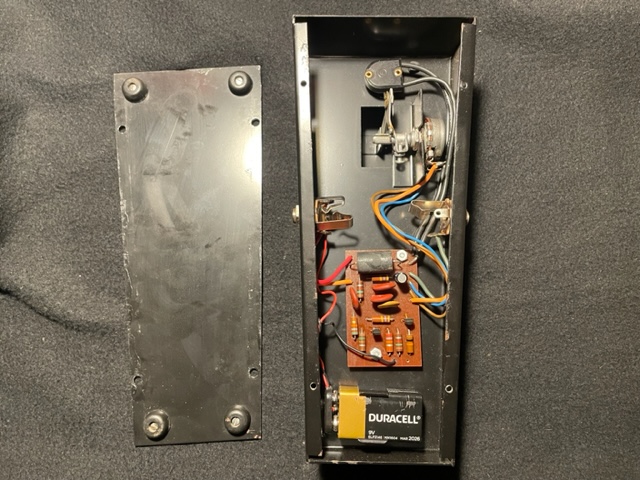 |
Here is the bottom side of the unit with the cover removed. It's immediately apparent that the bottom plate is not just a copy of the Shin Ei - there is no hinged battery door and it uses only four screws instead of six. The wiring is surprisingly heavy duty and is a mix of stranded and heavy gage solid core wires. |
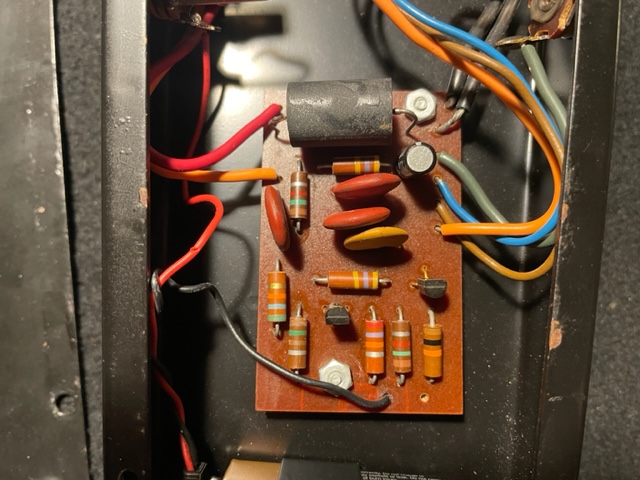 |
Close up of the PCB. The one thing that immediately catches the eye is the completely different looking inductor. All of the capacitors are 12V ceramic. They likely would exhibit some non-linearity, which likely adds some "complexity" to the sound character. |
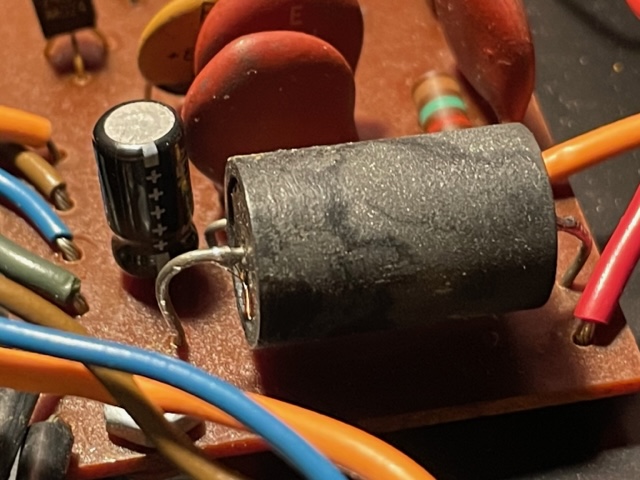 |
This is the axially mounted inductor. There are no markings on it that I can see. Appears to be windings on a cylindrical bobbin inside of a ferrite sleeve. It measures 430mH with 41 ohms of DC resistance. Curve tracer testing did not reveal anything special, looked like every other general purpose inductor I've tested. This was not the results that I expected! |
 |
The PNP transistors are 2N4121s, made by Motorola. It appears that they were made in the 24th week of 1970. That is likely around the time this example was made. |
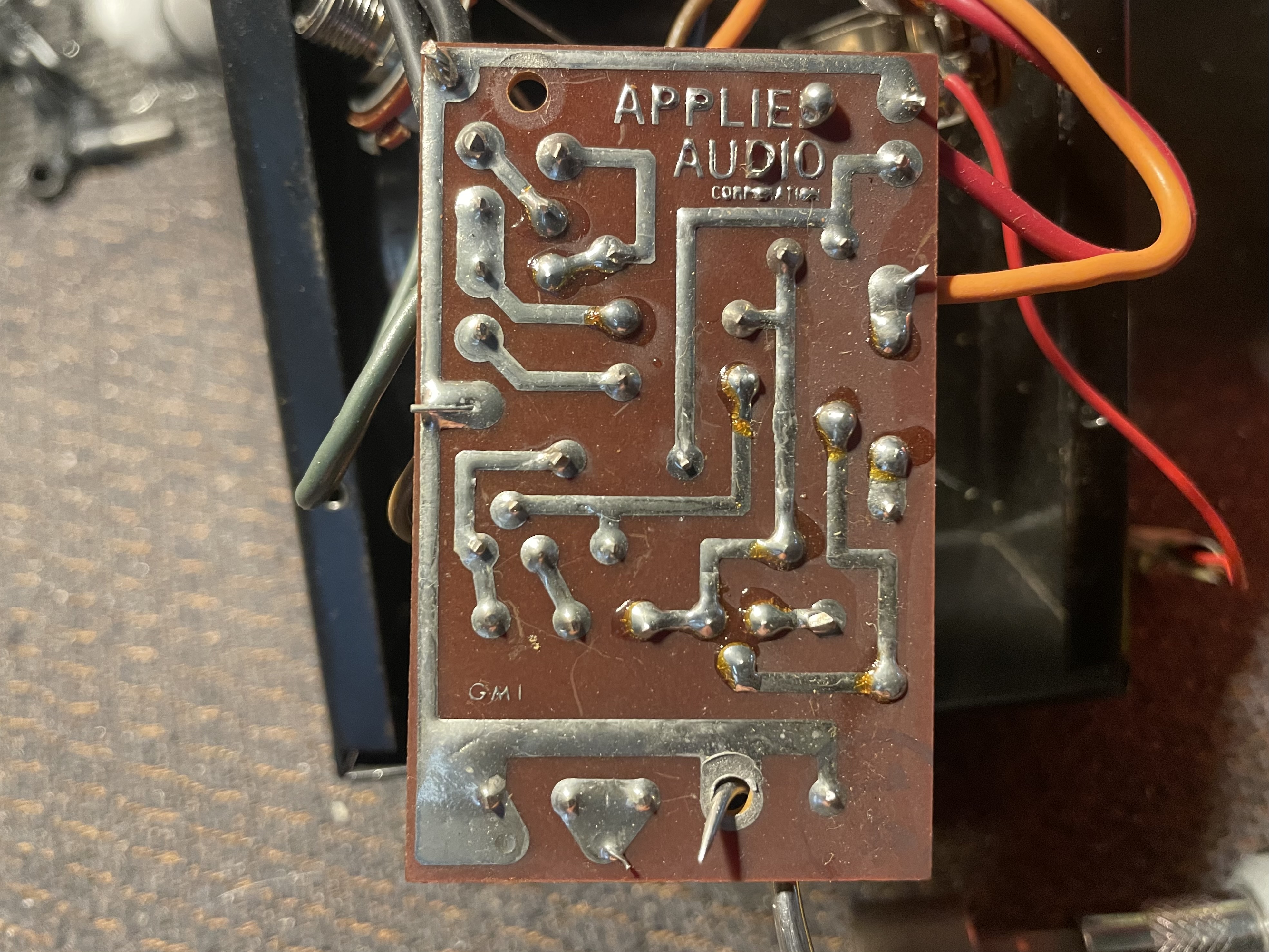 |
When you look at the bottom of the PCB there's no question as to who made it. |
 |
Here is a view of the very simple linkage system. The part that connects to the shaft of the pot is a rather odd arrangement but it works. As far as I can tell, once the unit was adjusted to their liking that they soldered the linkage to the shaft of the pot. Seems to be the case in most of the pictures I've seen of the insides of these wah pedals. |
 |
Another thing to add to the mystery are the pots they used. The date code on the pot is "1346236", which indicates that it was made by Centralab in the 36th week of 1962. I'm guessing they must have bought a bunch of surplus pots and put them in these pedals. Once again, it appears from the pictures I can find that these were commonly used. Another oddity is that it appears to be a 350K pot. It measured 330K. |
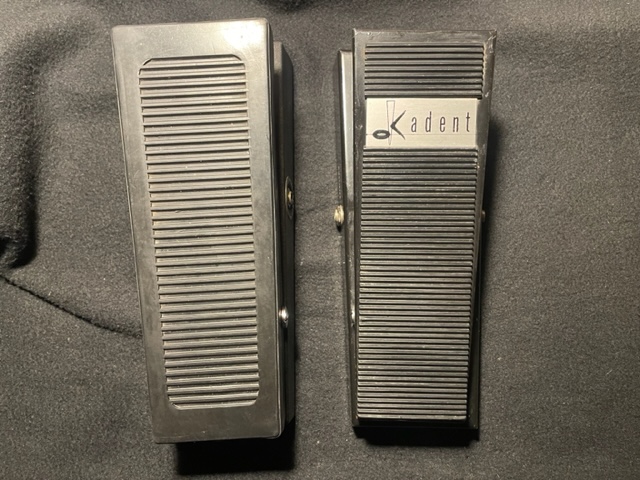 |
Here is the Kadent wah pedal next to the Shin Ei WT-1 Companion wah pedal. While the bottom size and shapes are nearly indentical, the treadles are obviously not the same and the Kadent is a bit more heavy than the Shin Ei is. |
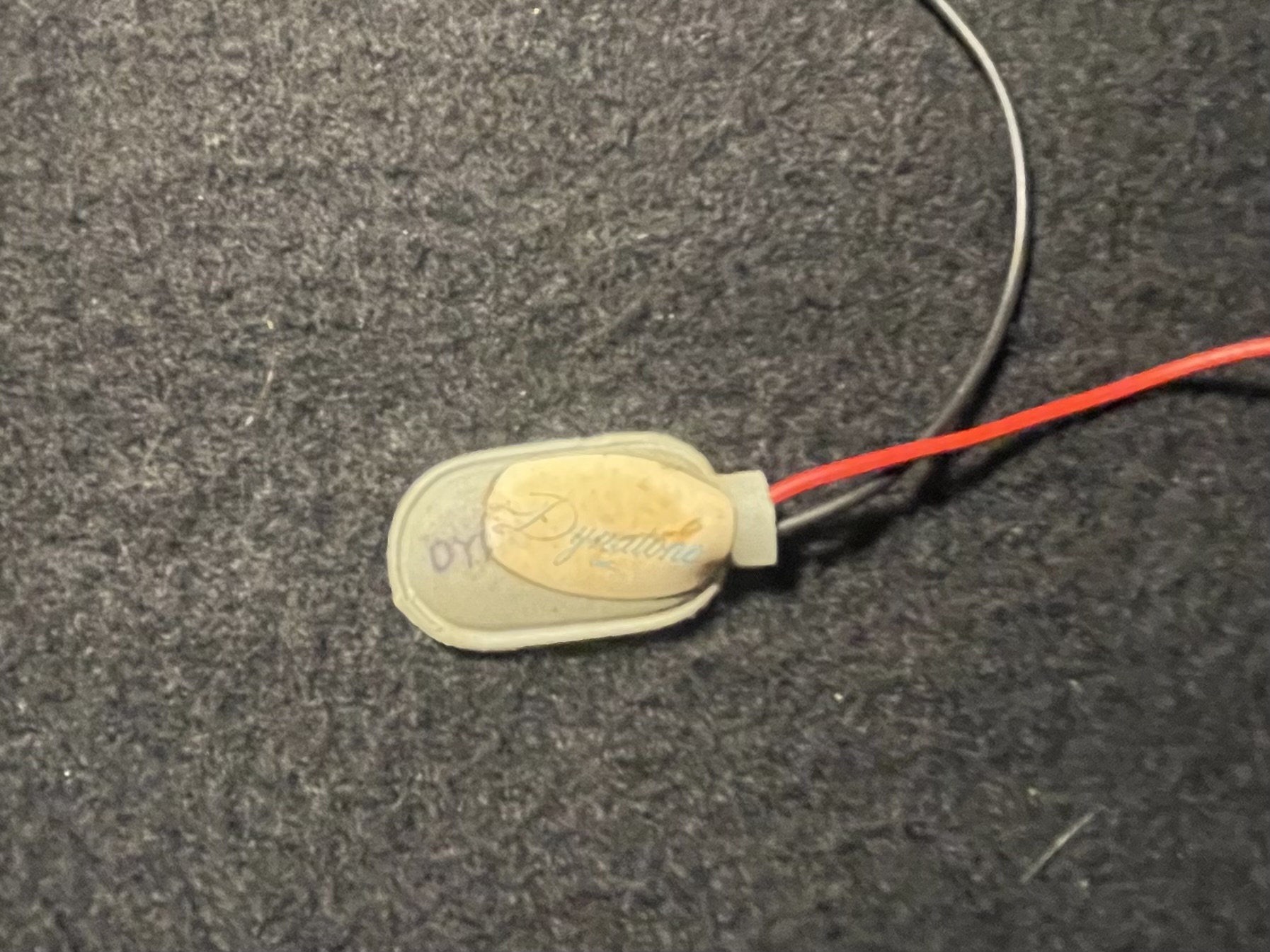 |
This is the original "Dynatone" battery snap that came in the pedal. It disintegrated when I went to change the battery, which appears to have been in this pedal for nearly 20 years. I wish they were still around, sounds like something that all of my guitar pedals need! lol |
Overall I am very happy with this wah pedal. I do not recall ever seeing one of these over the last 20 years or so. There must be not very many of them around today but if you stumble upon any one of these wah pedals made by Applied Audio I recommend that you buy it. They are not quite the very cheaply made budget wah pedals as you might believe. It really does sound as good as my Italian made Vox wah with an orignal Fasel inductor! With a better bypass switch or just true bypassing the circuit, it will serve you well. The swell feature is also pretty nice. I don't normally ever use the volume pedal function of a wah/swell pedal but this one actually is very nice.
